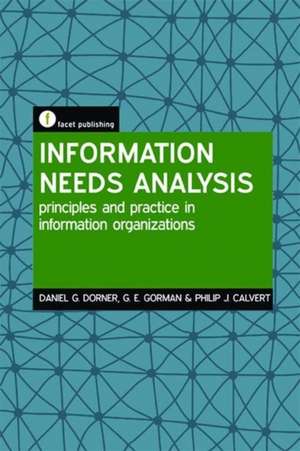Information Needs Analysis: Principles and Practice in Information Organizations
Autor Daniel G. Dorner, G. E. Gorman, Philip J. Calverten Limba Engleză Hardback – 31 mar 2019
Analysing and assessing the information needs of clients is key to the provision of effective service and appropriate collections in both face-to-face and virtual library services. The importance of information needs analysis is widely recognized by information professionals, but currently there is little substantive, detailed work in the professional literature devoted to this important topic.
This new book is designed to fill that gap, by supporting practitioners in developing an information needs analysis strategy, and offering the necessary professional skills and techniques to do so. It will offer guidance to team leaders and senior managers in all areas of library work, especially those involved in collection management, service provision and web development, and is equally applicable to the needs of academic, public, government, commercial and other more specialized library and information services.
Preț: 732.82 lei
Preț vechi: 1171.34 lei
-37% Nou
Puncte Express: 1099
Preț estimativ în valută:
140.23€ • 144.89$ • 116.65£
140.23€ • 144.89$ • 116.65£
Carte nepublicată încă
Doresc să fiu notificat când acest titlu va fi disponibil:
Se trimite...
Preluare comenzi: 021 569.72.76
Specificații
ISBN-13: 9781783302970
ISBN-10: 1783302976
Pagini: 256
Dimensiuni: 156 x 234 x 21 mm
Greutate: 0.26 kg
Ediția:1
Editura: Facet Publishing
Colecția Facet Publishing
ISBN-10: 1783302976
Pagini: 256
Dimensiuni: 156 x 234 x 21 mm
Greutate: 0.26 kg
Ediția:1
Editura: Facet Publishing
Colecția Facet Publishing
Public țintă
Professional Practice & DevelopmentCuprins
1. Background to needs analysis for information managers Introduction Information needs analysis rather than information needs assessment Understanding the concept of need Defining ‘needs’ in relation to ‘wants’ and ‘demands’ Defining information needs analysis Types of information needs Reasons for conducting an information needs analysis Review of Chapter 1 Further reading References 2. The importance of context in information needs analysis Introduction The cultural context Information needs awareness in context Purpose and perceived importance Determining the communities Making use of existing data Review of Chapter 2 Further reading References 3. Models and types of information needs analysis Introduction The literature The system approach The target group approach The contexts of needs assessments Comparing the perspectives Information needs analyses in information management contexts Review of Chapter 3 Further reading References 4. The stages of information needs analysis Introduction Four stages of needs analysis The recursive nature of INA research Qualitative and quantitative frameworks for data analysis The stages of ex post intervention Review of Chapter 4 Further reading References Appendix 4.1: Gantt chart 5. Gathering data for information needs analyses Introduction How we have reached this juncture The primary research question The research population The data-gathering method Data analysis Validity and reliability Ethical considerations Practical issues to consider when choosing a method The main data-gathering methods Examples of data-gathering methods selected in INAs Review of Chapter 5 Further reading References 6. Gathering data from existing sources Introduction The data External data Internally created data The methods Conclusion Review of Chapter 6 Further reading References 7. Gathering data through surveys Introduction What is a survey? Planning for a survey Conducting a survey Preparing for data analysis Review of Chapter 7 Further reading References 8. Gathering data through interviews Introduction Thoughts on managing qualitative data collection Interviews Focus groups Observation Other qualitative methods Review of Chapter 8 Further reading References 9. Analysing and integrating information needs analysis data Introduction Analysing and integrating information The information analysis stage in the INA process Qualitative data Quantitative data Descriptive statistics Inferential statistics Review of Chapter 9 Further reading References 10. Reporting on an information needs analysis Introduction The audience and its impact on the final report Validity and reliability The writing process The structure of an INA report The use of graphics Other means of communicating the results Review of Chapter 10 Further reading References
Notă biografică
Daniel G. Dorner is Senior Lecturer
G E Gorman is Professor of Library and Information Management
Philip J Calvert is Senior Lecturer at the School of Information Management, Victoria University of Wellington, New Zealand.
G E Gorman is Professor of Library and Information Management
Philip J Calvert is Senior Lecturer at the School of Information Management, Victoria University of Wellington, New Zealand.
Descriere
If you want to provide an information service that truly fulfils your users' needs, this book is essential reading. It will offer guidance to team leaders and senior managers in all areas of library work, especially those involved in collection management, service provision and web development, and is equally applicable.
